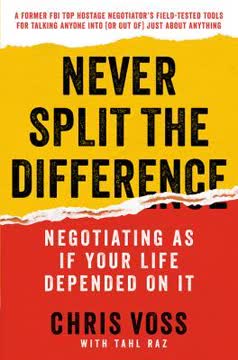Key Takeaways
1. Reject "Win-Win" Negotiation: Start with "No" for Better Deals
"No" is a real decision that induces the party across the table into actually thinking about why they've just said "no."
Embrace "no" as a starting point. The conventional "win-win" approach often leads to unnecessary compromises and emotion-based decisions. Instead, encourage your adversary to say "no" early in the negotiation. This creates a real decision point and forces both parties to think critically about their positions.
Benefits of starting with "no":
- Clears the air of false expectations
- Encourages honest communication
- Provides a foundation for substantive discussion
- Reduces the risk of premature compromise
By allowing and even inviting "no," you create an environment where both parties can make informed, rational decisions rather than being swayed by emotional pressures or the desire to appear agreeable.
2. Cultivate a Blank Slate Mindset: Avoid Assumptions and Expectations
Blank slate is a key behavioral goal that you will have to practice over and over and over.
Eliminate preconceptions. Approaching each negotiation with a blank slate allows you to truly listen and understand your adversary's position without being clouded by your own assumptions or expectations.
Key practices for maintaining a blank slate:
- Take thorough notes during meetings
- Listen actively without interrupting
- Avoid making premature judgments
- Ask clarifying questions to ensure understanding
- Regularly review and update your understanding of the situation
Cultivating this mindset requires constant practice and self-awareness. It enables you to gather accurate information, adapt to changing circumstances, and make decisions based on reality rather than preconceived notions.
3. Develop a Clear Mission and Purpose to Guide Negotiations
If every decision you make—even one that doesn't turn out well—is in the service of a sound mission and purpose, you cannot go wrong, not in the long run.
Define your guiding principles. A well-crafted mission and purpose statement provides a clear framework for decision-making throughout the negotiation process. It should be focused on your adversary's world, not your own.
Characteristics of an effective mission and purpose:
- Set in the adversary's world
- Concise and easily understood
- Written down for clarity and commitment
- Supports long-term goals beyond the current negotiation
- Flexible enough to adapt to changing circumstances
Your mission and purpose act as a north star, helping you navigate complex negotiations and avoid getting sidetracked by short-term gains that may compromise your overall objectives.
4. Focus on Behavior and Actions, Not Outcomes
As negotiators, we must take the same approach. If you can emulate Columbo's unokayness to even a small degree, in your own way, you will exponentially increase your negotiating success.
Control what you can control. Instead of fixating on outcomes, which are often beyond your direct influence, concentrate on your behavior and actions throughout the negotiation process. This approach keeps you focused and adaptable.
Key behaviors to cultivate:
- Maintain a calm and composed demeanor
- Ask thoughtful, probing questions
- Listen actively and take thorough notes
- Respond to new information without emotional reactions
- Consistently refer back to your mission and purpose
By focusing on your own behavior, you create an environment conducive to productive negotiation and increase your chances of achieving favorable outcomes, even if they differ from your initial expectations.
5. Ask Effective Questions to Uncover the Adversary's World
Questions are the means by which the negotiator helps the adversary do this. The adversary's answers to our questions build the vision that he needs to make decisions.
Master the art of questioning. Effective questions are the key to understanding your adversary's perspective, needs, and motivations. They allow you to gather crucial information while maintaining control of the conversation.
Guidelines for effective questioning:
- Use interrogative-led questions (who, what, when, where, why, how)
- Keep questions short and focused
- Ask one question at a time and listen carefully to the answer
- Use nurturing language to make the adversary comfortable
- Employ reversing techniques to redirect unwanted questions
By asking the right questions, you not only gain valuable insights but also help your adversary clarify their own thoughts and reach decisions that align with your objectives.
6. Understand and Paint the Adversary's "Pain"
As a negotiator, you can and will make a lot of mistakes, of course, but your clear vision of your adversary's pain will see you through thick and thin.
Identify and address the core problem. Understanding your adversary's "pain" – their current or future challenges – is crucial for creating compelling solutions and driving decisions.
Steps to effectively paint the pain:
- Research thoroughly to understand the adversary's context
- Ask probing questions to uncover hidden concerns
- Listen carefully for implied problems or dissatisfactions
- Present your solution in terms of addressing their specific pain points
- Use nurturing language to make the adversary comfortable discussing challenges
Remember that you're not creating pain, but rather helping the adversary see and understand their existing challenges more clearly. This understanding forms the basis for mutually beneficial solutions.
7. Build and Manage Negotiation Budgets: Time, Energy, Money, and Emotion
Budget in the Camp System breaks down into three budgets that help us account for and control this real price in time-and-energy, money, and emotional investment.
Track all negotiation investments. Recognizing that negotiations involve more than just financial costs, create and manage budgets for time, energy, money, and emotional investment. This comprehensive approach helps you maintain control and make informed decisions throughout the process.
Key aspects of negotiation budgets:
- Time-and-Energy: Schedule, preparation, meetings, follow-ups
- Money: Direct costs, opportunity costs, potential gains/losses
- Emotion: Stress, excitement, frustration, confidence
By actively managing these budgets, you can avoid overinvestment in unproductive negotiations, maintain leverage, and make rational decisions based on a full understanding of the costs involved.
8. Identify Real Decision Makers and Navigate Blockers
As a negotiator, you can and will make a lot of mistakes, of course, but your clear vision of your adversary's pain will see you through thick and thin.
Find the true power players. Understanding the decision-making structure within your adversary's organization is crucial for effective negotiation. Identify both the real decision makers and potential blockers who may impede progress.
Strategies for navigating decision structures:
- Ask direct questions about the decision-making process
- Research the organization's hierarchy and culture
- Build relationships at multiple levels within the organization
- Use nurturing techniques to work with blockers constructively
- Be prepared to escalate or redirect conversations as needed
By focusing your efforts on the right people and understanding the dynamics at play, you can streamline the negotiation process and increase your chances of success.
9. Create and Negotiate Agendas for Every Interaction
The only agenda that is valid for purposes of negotiation is the one that has been negotiated with an adversary.
Structure every interaction. Create and negotiate agendas for all meetings, calls, and even emails. This practice keeps negotiations focused, productive, and under control.
Key components of effective agendas:
- Problems to be addressed
- Your "baggage" (potential biases or concerns)
- Their "baggage"
- What you want to achieve
- Next steps
By explicitly negotiating these agendas with your adversary, you ensure mutual understanding, set clear expectations, and maintain control over the direction of the negotiation.
10. Present Your Case Strategically, If at All
The greatest presentation you will ever give is the one your adversary never sees.
Rethink the traditional presentation. Instead of relying on formal presentations to convey your case, focus on guiding your adversary to reach their own conclusions through strategic questioning and problem-solving.
Alternatives to traditional presentations:
- Collaborative problem-solving sessions
- Guided discovery through targeted questions
- Incremental information sharing based on adversary interest
- Real-time demonstrations or experiments
- Story-telling and case studies that relate to the adversary's situation
By moving away from one-sided presentations, you engage your adversary more deeply in the process, increase their investment in the outcome, and improve the likelihood of reaching a mutually beneficial agreement.
Last updated:
FAQ
What's Start with NO about?
- Contrarian Approach: Start with NO by Jim Camp challenges the traditional "win-win" negotiation philosophy, advocating for starting with "no" to maintain control.
- Decision-Based System: The book introduces a system that focuses on understanding the adversary's world and making decisions based on a clear mission and purpose.
- Practical Techniques: It offers techniques like asking questions, nurturing relationships, and using the "strip line" method to manage negotiations effectively.
Why should I read Start with NO?
- Fresh Perspective: If conventional negotiation tactics have failed you, this book provides a new approach that challenges the status quo.
- Proven Strategies: Jim Camp shares strategies tested in real-world scenarios, enhancing your negotiation skills.
- Focus on Control: The book emphasizes controlling your actions and decisions, leading to more successful negotiations.
What are the key takeaways of Start with NO?
- Start with "No": Initiating negotiations with "no" creates a clear decision point and engages the adversary in meaningful dialogue.
- Mission and Purpose: Establishing a valid mission and purpose guides decision-making and helps avoid unnecessary compromises.
- Control Your Behavior: Focus on behaviors and actions you can control, reducing neediness and emotional responses.
What is the Camp System in Start with NO?
- Decision-Based Negotiation: The Camp System emphasizes decision-making over emotional responses, focusing on actions and behaviors.
- Key Principles: It includes starting with "no," nurturing relationships, and using effective questioning techniques.
- Practical Application: The system provides actionable advice applicable in various negotiation contexts.
What is the significance of starting with "no" in negotiations according to Jim Camp?
- Encourages Clarity: Starting with "no" clarifies the negotiation's direction and allows for meaningful discussions.
- Reduces Neediness: It helps negotiators avoid appearing desperate, fostering control and confidence.
- Invites Dialogue: A clear "no" invites further conversation, encouraging critical thinking about positions.
How does the concept of mission and purpose apply to negotiations in Start with NO?
- Guides Decision-Making: A valid mission and purpose provide a framework for decisions during negotiations.
- Sets Context: It should be set in the adversary's world, fostering collaboration and understanding.
- Enhances Effectiveness: Adhering to a clear mission aligns actions with long-term objectives.
What are the "fuels" of the Camp System in Start with NO?
- Questions as Fuels: Effective questions lead to deeper understanding and insight, uncovering the adversary's needs.
- Supporting Fuels: Nurturing, reversing, connecting, and the "3+" technique support the questioning process.
- Behavioral Goals: Each fuel represents a behavioral goal, helping navigate negotiations effectively.
How can I effectively use questions in negotiations according to Jim Camp?
- Ask Open-Ended Questions: Use questions to encourage dialogue and gather information, like "What are your thoughts?"
- Practice the Reverse: Respond to questions with questions to gain more insight and focus on the adversary's needs.
- Nurture with Your Tone: A nurturing tone creates a comfortable environment, encouraging open engagement.
What is the "strip line" method in negotiations from Start with NO?
- Managing Pressure: The "strip line" method releases pressure from the adversary, maintaining a calm atmosphere.
- Avoiding Emotional Swings: It prevents emotional swings that can derail negotiations, focusing on productive dialogue.
- Encouraging Open Communication: This method fosters an environment for open discussion without fear of pressure.
What is the "blank slate" concept in Start with NO?
- Active Listening: Enter negotiations without preconceived notions, fully absorbing new information.
- Eliminating Assumptions: Avoid assumptions to focus on understanding the adversary's needs and concerns.
- Enhancing Decision-Making: This approach fosters clearer decision-making and adaptability.
How does Jim Camp define "negative strip lines"?
- Emotional Neutralization: Negative strip lines acknowledge and neutralize negative emotions, shifting focus to dialogue.
- Engaging the Adversary: They create a connection, encouraging critical thinking about positions.
- Example in Practice: Camp uses a courtroom example to illustrate engaging the jury and shifting emotional states.
What is the "no closing" principle in Start with NO?
- Avoiding Neediness: Do not pressure adversaries to make decisions, as it can create neediness.
- Encouraging Open Dialogue: Refrain from closing tactics to foster open and honest dialogue.
- Empowering the Adversary: Allowing the adversary the freedom to say "no" can lead to favorable outcomes.
Review Summary
Start with NO receives mixed reviews. Some praise its unconventional approach to negotiations, focusing on allowing the other party to say "no" and avoiding neediness. Readers appreciate the tactical advice and perspective shift. However, critics find the book long-winded, repetitive, and overly focused on large corporate deals. Many note the author's aggressive tone and lack of practical examples for smaller negotiations. While some find value in its core concepts, others prefer alternative negotiation books that offer more relatable and concise guidance.
Similar Books










Download PDF
Download EPUB
.epub digital book format is ideal for reading ebooks on phones, tablets, and e-readers.




